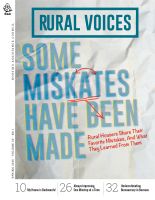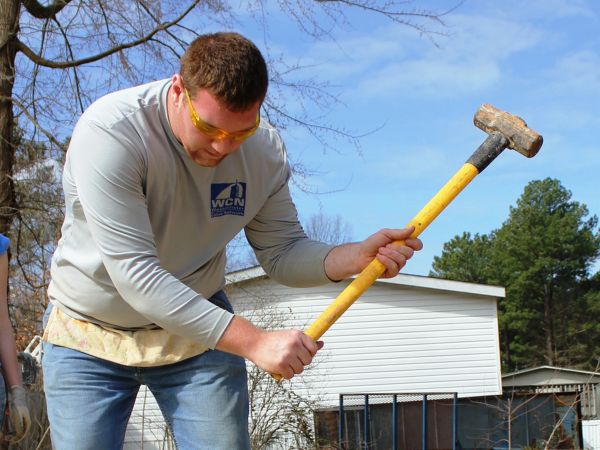Some Mistakes Have Been Made
Rory Doyle / There Is More Work To Be Done
Rory Doyle / There Is More Work To Be Done
 This story appears in the 2015 Spring Edition of Rural Voices
This story appears in the 2015 Spring Edition of Rural Voices
by Laura Buxbaum
When I joined CEI as its Director of Housing Resource and Policy Development in 2008, the organization had just begun to develop a new five-year strategic plan. The planning process included a critical look at CEI’s housing development program, which was at a crossroads. CEI was reevaluating its historic housing activity and its current place in the market. One reason for this self-examination was that, as the country was waking up to the full brunt of the housing crisis, CEI, too, awoke to a harsh realization: its housing portfolio was in danger of sinking under the weight of non-performing assets.
The heaviest burden was represented by the 16 remaining homes in our 12-year-old lease-to-purchase program. From the perspective of 2008, this program looked like the culmination of a long series of bad decisions. The properties were scattered from Parsonsfield on the New Hampshire border to Bremen, on the midcoast, to St. Albans, 125 miles north of the southernmost property. CEI’s Construction Analyst noted that “it could take two days to drive to all the sites – if you did nothing but drive.” Seven of the homes were vacant. The occupied homes were inhabited by tenants who had lived there long past the two-year lease/purchase limit. At least three tenants were more than $15,000 in arrears. And due to a combination of plummeting home values, deferred maintenance and, in some cases, tenant damage, all were worth considerably less than CEI had originally paid for them. In 2008, this picture looked like a failed program.
At the time, we didn’t do a lot of soul-searching about how we got there – we just knew it was time to get out. Over the next three or four years, staff worked aggressively to minimize losses and dispose of the properties. Some were sold to the existing residents;
some tenants were evicted; all but one property was sold and we heaved a sigh of relief.
 Corey Benedict on Spring Break 2012 – WCN 24-7 – Creative Commons
Corey Benedict on Spring Break 2012 – WCN 24-7 – Creative Commons
But now, with time to reflect, we ask the ques- tions: How did we get there? What might CEI have done differently? What are the specific challenges in a rural state? Was the program really a complete disaster? And would we ever, under any circumstances, offer a lease-purchase program again?
Some background: CEI is a Maine-based Community Development Corporation (CDC) and Community Development Financial Institution (CDFI) founded in 1977 with a mission to help create economically and environmentally healthy communities in which all people, especially those with low incomes, can reach their full potential. From the early years, CEI’s focus was on economic development and business assistance – lending, investment and technical assistance for entrepreneurs and existing businesses, from microenterprises to medium-sized enterprises providing jobs and community economic benefits. While the majority of CDCs began with a focus on housing, for CEI housing came later. As we worked with businesses and low-income communities, we saw the need for affordable rental housing and homeownership, and in 1989 CEI hired a Housing Director and began some small-scale development.
CEI began the lease/purchase program in the mid-1990s, for a number of very good reasons:
The program was targeted to low-income residents. Homebuyer education, counseling, and ongoing case management were built into the program. In the beginning years, with full funding and staffing and a favorable real estate market, the program worked well. Of the 13 properties purchased in 1996 and ’97, 11 were sold to the original tenants – seven within the two-year lease/purchase period. By 2002, the program had served 41 participants. CEI received more grants and low-cost loan capital, enabling the program to ultimately acquire 67 homes.
But by 2001, issues were beginning to emerge. There had been some changes in the program, including staff. From the original model of purchasing foreclosed homes at auction and then finding program participants, the program had moved to a model of finding participants and having them find homes to purchase. While this may have served to increase client satisfaction, it resulted in properties that were widely scat- tered geographically and had a higher purchase price (prices also rose as time went on). In addi- tion, many of the properties required extensive rehab and repairs.
At the time, we didn’t do a lot of soul- searching about how we got there – we just knew it was time to get out.
As first-time homebuyers, most participants did not have expertise in purchasing or evaluating a home, and many seriously underestimated the time, expense, and skill needed to undertake needed repairs. While the initial properties were rehabbed by YouthBuild, later participants were expected to conduct their own repairs. If exten- sive rehab was needed that the lease-purchase client did not have the money or skills to ac- complish, CEI would provide the improvements and add the cost to the ultimate purchase price.
It’s also worth noting that the program was growing in the context of a hot real estate market. The assumption – one shared by the whole country – was that values would continue to climb. This was a dangerous assumption in hindsight.
A 2002 internal evaluation noted that “the lease-to-own period is financially trying for participants. Many of [them] come from a po- sition of having no savings, and then CEI asks them not only to begin putting money away, but also to continue paying comparable rent, invest in house repairs, and pay off preexisting debt.”
The evaluation also noted the slow turnover rate – at that point, only nine of 41 participants had successfully purchased their homes. Many participants had suffered life events such as illness, divorce or job loss. For others, the pro- cess of credit repair and building their savings simply took longer than expected. This left CEI in the position of serving as a scattered-site landlord of properties that often required more maintenance than their residents could provide. At the same time as CEI was trying to provide housing and financial counseling. It seems in retrospect that boundaries and roles may not always have been clear – CEI was, and is, a very mission-driven organization, and its staff wanted each participant to achieve success. It took a truly drastic situation for CEI to evict a participant.
The 2002 evaluation made some recommendations to help the program work more effec- tively. In the next four years CEI sold 28 more homes, 20 of them to the original lease-purchase tenants. CEI also continued to admit participants and purchase homes, though at a slower pace. In the meantime, foundation grants were becoming more competitive and less rich, and program staff was reduced from two full-time staff plus a housing counselor to one staff person with multiple roles and a housing counselor. In the end, we can say that the program did have some successes:
Based on the experience of CEI’s lease-purchase program, we’ve developed a list of Do’s and Don’ts for anyone considering a similar effort:
|
DON’TS |
DO’S |
|
CEI allowed participants to choose their homes from the market, and these were frequently the cheapest available, with extensive rehab and maintenance needs. This compromised the value of the collateral and the ability to recover CEI’s investment, and place a financial burden on both the tenant and CEI to accomplish needed repairs. |
Develop or purchase quality homes that will retain their value, not strain the budgets of participants, and protect your investment. |
|
Homes were widely scattered geographically, making it difficult to keep up with property management and resident assistance. |
Define a geographically limited, manageable area. |
|
Homebuyer education and counseling, while helpful, may not be enough for some low-income participants to achieve and sustain homeownership. For participants who are already on the edge financially, any crisis can derail homeownership. |
Consider a higher income target and tighter parameters for participant selection. Provide ongoing, hands-on support, especially for participants who encounter unanticipated maintenance costs or face major challenges such as divorce, job loss or health problems. |
|
Don’t bury your head in the sand if things aren’t working out. |
Deal with delinquency promptly. Transition participants out of the program if they don’t work to improve their credit, save for a downpayment, budget for maintenance, and become “bankable.” Be willing to evict participants who fail to pay rent and don’t work to address the problems. |
|
Don’t assume that participants have the knowledge, skills or capacity to adapt to difficult situations and added costs such as a crowded or substandard home, a long commute that adds expense, or a long do-it-yourself repair list. |
Guide participants toward a sustainable situation that will allow for a comfortable life that isn’t burdened by unnecessary challenges. |
|
Don’t assume that the market will continue to rise or hold steady. |
If a property is vacant or losing money and the lease-purchase option has failed, sell promptly – even if it means a loss. |
It is timely to reflect on these lessons. The economy and real estate market are in a similar place as at the beginning of the lease-pur- chase program. Home values are low in the wake of the economic and foreclosure crisis, but they are rising. Credit for low- and mod- erate-income buyers is extremely tight, and many would-be purchas- ers may have suffered financial and credit damage in the past several years due to job loss, foreclosure, or bankruptcy. Sometimes we view this economic landscape and consider whether the time is right for a new lease-purchase program. We don’t know if we’ll ever try again – but we do know that a new program would be designed with much tighter parameters, with adequate, long-term funding for both program and capital costs, and with full understanding of the lessons learned the first time around.
Laura Buxbaum is Director of Housing Resource and Policy Development for CEI. Laura has worked in community development and nonprofit administration since 1992. She has worked as a community organizer and planner, a program director, deputy director and executive director. She is a member of the Board of Directors of the Maine Affordable Housing Coalition and of the National Rural Housing Coalition